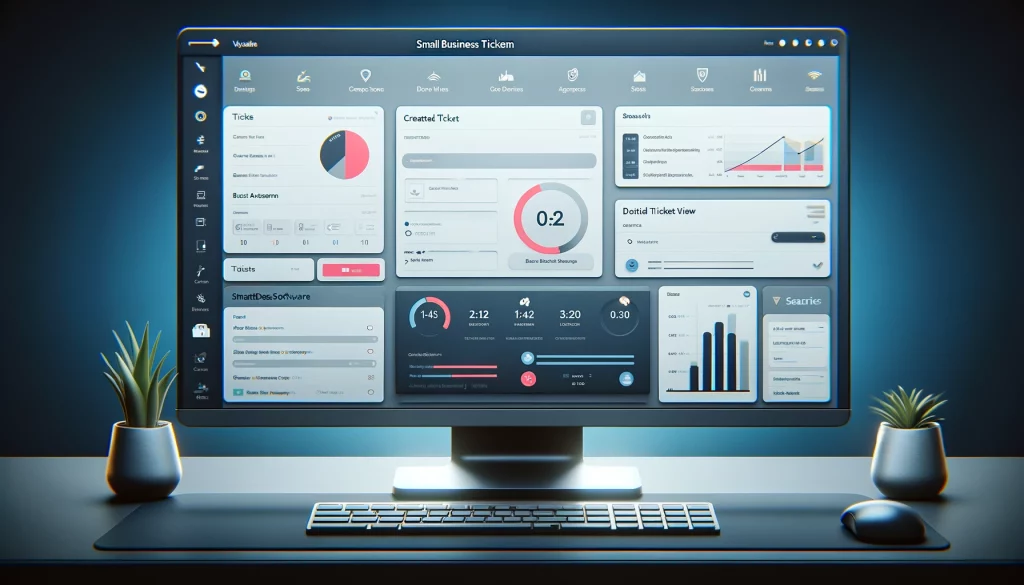
Small businesses must leverage every tool at their disposal to stand out, especially when it comes to customer service. A robust helpdesk or ticketing system is not just a necessity but a strategic asset that can dramatically improve customer satisfaction and operational efficiency. This guide delves into the best practices for setting up a helpdesk or ticketing system tailored to the unique needs of small businesses.
Setting up a helpdesk or ticketing system for a small business involves several best practices to ensure efficiency, customer satisfaction, and scalability. Here’s a comprehensive list of practices to consider:
1. Identify Your Needs and Objectives
- Understand the specific needs of your business and customers.
- Determine what you want to achieve with the ticketing system (e.g., faster response times, better issue tracking).
2. Choose the Right Software
- Opt for a ticketing system that fits your business size, budget, and requirements.
- Consider scalability, ease of use, integration capabilities, and support when selecting software.
3. Simplify the Ticket Submission Process
- Ensure the ticket submission process is straightforward for customers.
- Provide multiple channels for ticket submission (email, web form, phone, chat).
4. Implement an Efficient Ticket Management System
- Utilize categorization, tagging, and prioritization to organize tickets.
- Set up automated workflows for common issues to speed up resolution times.
5. Establish Clear Support Policies and SLAs (Service Level Agreements)
- Define and communicate clear policies regarding response and resolution times.
- Set realistic expectations for customers to improve satisfaction.
6. Train Your Team
- Provide comprehensive training on the ticketing system and customer service best practices.
- Encourage continuous learning and adaptation to new tools and processes.
7. Utilize Automation and AI Tools
- Leverage automation for routine tasks and inquiries to improve efficiency.
- Consider AI tools for ticket categorization, prioritization, and even initial responses.
8. Monitor and Analyze Performance
- Regularly review key performance indicators (KPIs) like resolution time, customer satisfaction scores, and ticket volume trends.
- Use insights from data to make informed improvements.
9. Gather Customer Feedback
- Implement mechanisms for collecting customer feedback on their support experience.
- Use this feedback to identify areas for improvement and training opportunities.
10. Ensure Security and Compliance
- Protect sensitive customer data in compliance with relevant regulations (e.g., GDPR, HIPAA).
- Regularly update and patch your system to safeguard against vulnerabilities.
11. Foster a Customer-Centric Culture
- Encourage a culture that prioritizes customer satisfaction and proactive support.
- Empower your team to go above and beyond in solving customer problems.
12. Plan for Scalability
- Anticipate future growth and choose a system that can scale with your business.
- Regularly reassess your needs and the capabilities of your ticketing system.
By following these best practices, you can set up a helpdesk or ticketing system that not only meets the current needs of your small business but also adapts to its future growth and changes in customer expectations.
Let’s discuss them in little more detail;
Identifying Your Needs and Objectives
The foundation of any successful helpdesk system is a clear understanding of your business’s and customers’ needs. Determine what issues your customers are facing and what outcomes you desire from the ticketing system, such as improved response times or better issue resolution. This step guides the entire setup process, ensuring that your chosen solution aligns with your business objectives.
Choosing the Right Software
Selecting the right ticketing software is crucial. Small businesses must balance functionality with affordability, opting for solutions that offer scalability, user-friendly interfaces, and seamless integration with existing tools. Look for software that supports automation, AI capabilities, and provides comprehensive support and training materials.
Simplifying the Ticket Submission Process
The easier it is for customers to reach out for help, the better. A straightforward ticket submission process across various channels (email, web, phone, chat) ensures that customers can easily report their issues without frustration. This accessibility improves the overall customer experience and speeds up the resolution process.
Implementing an Efficient Ticket Management System
An organized ticket management system is key to handling customer inquiries efficiently. Utilize features like tagging, categorization, and prioritization to keep tickets organized. Automated workflows can help direct common issues to predefined solutions, streamlining the resolution process.
Establishing Clear Support Policies and SLAs
Clear communication about what customers can expect in terms of response and resolution times sets the stage for a transparent relationship. Establish and communicate clear support policies and Service Level Agreements (SLAs) to manage expectations and foster trust.
Training Your Team
A well-trained team is the backbone of effective customer support. Invest in comprehensive training on both the technical aspects of the ticketing system and the soft skills necessary for exceptional customer service. Encourage ongoing learning to adapt to evolving customer needs and technology updates.
Utilizing Automation and AI Tools
Automation and AI can significantly enhance the efficiency of your ticketing system. From auto-assigning tickets to appropriate team members to using chatbots for initial customer interactions, these tools can reduce the workload on your staff and speed up response times.
Monitoring and Analyzing Performance
Regular analysis of performance metrics like ticket resolution times, customer satisfaction scores, and the volume of incoming tickets is essential. This data provides insights into the effectiveness of your helpdesk system and highlights areas for improvement.
Gathering Customer Feedback
Direct feedback from customers about their support experience is invaluable. Implement feedback mechanisms to understand customer satisfaction and identify opportunities to enhance your service.
Ensuring Security and Compliance
With the increasing importance of data security, ensuring your ticketing system complies with relevant regulations (e.g., GDPR, HIPAA) is non-negotiable. Regular updates and security measures protect your customers’ information and your business’s reputation.
Fostering a Customer-Centric Culture
A helpdesk or ticketing system is only as effective as the team behind it. Cultivate a culture that values customer satisfaction above all, empowering employees to provide exceptional service and resolve issues proactively.
Planning for Scalability
As your business grows, so too will your customer service needs. Choose a ticketing system that can scale with your business, offering the flexibility to expand features and capabilities as required.
Conclusion
Implementing a helpdesk or ticketing system is a strategic decision that can significantly impact your small business’s success. By following these best practices, you can create a system that not only addresses current customer service needs but also positions your business for future growth and success. Remember, the goal is not just to solve customer issues but to do so in a way that enhances their overall experience with your brand.
Check how ZNICRM Small Business Ticketing System can help you in achieving best customer satisfaction from https://znicrm.com/features-helpdesk-ticketing.php
